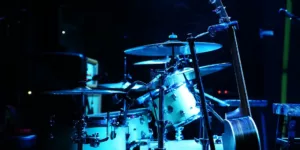The presence and dynamics of a drum kit are quite difficult to reproduce electronically. Most drummers would not use a full electronic set during live performances for this reason. However, drum sets often lack sound variety when playing to heavily produced genres like dance and pop.
This is even more prevalent when playing in small venues with poor sound. The drums may be perceived as extremely flat in comparison to the audience’s growing expectations of production quality. The kick drum can often sound like a beater hitting a piece of plastic, without its signature punchy bass presence.
This is where hybrid drum setups shine. They allow drummers to the tap into the best of what both the acoustic and electronic world has to offer.
This article explains how drummers can introduce electronic drum elements into their acoustic setup. This can open them up to new sonic possibilities and improve their live sound.
We also cover some other interesting developments in drumming technology, from air drumming innovations to an oddball drum machine.
Blending your sounds using drum triggers
You can blend drums with electronic samples through the use of drum triggers. These simply attach to your drum head and detect hits through a simple sensor. They can send a signal via MIDI to an external module or DAW, which produces the sound.
You can attach this to a kick drum and blend it with a punchy bass sample. You can alter the pitch of the sample via a drum trigger module to match the natural frequency of your drum head. Often times, audiences will often not even realize you are using a drum trigger. They generally just think that the live sound engineering is of high quality.
This is not a new development. Heavy metal drummers have been using them for years to increase the sound of their double-kicks.
You have even more freedom if you are playing in a genre that needs more obvious electronic samples. Quality snare drum triggers often have dual-sensors that can recognize hits on the rim. You can use this to trigger higher velocity rimshot samples or electronic sounds like claps or special effects.
The cost of drum triggers are low and you can purchase them individually. You will need to connect them to external gear such as a drum trigger module or sample pad. These can also be purchased at low cost, which means that you can start small and then work your way to creating more complex kits.
Percussion and sample pads

One of the most common ways of introducing electronic sounds into your drum set is through the use of sample pads.
These are great stand-alone units with multiple playing surfaces in a grid. Some items are even sensitive enough to play with your hands.
No external modules are required if you are happy with the onboard sounds of these devices. This can make your setup much simpler and less prone to issues.
The quality of these devices can vary dramatically. In general, you should be paying over $600 for anything that will be taken seriously for live performances. Roland and Yamaha generally hold the reputation for the best quality pads.
The least invasive option is to simply set up your drum pad on a stand beside your hi-hat. You can reach for the pads in order to play samples that supplement your drum sound.
Drummers sometimes replace their rack toms with a sample pad. This sacrifices some acoustic qualities in favor of a drum pad that is a lot more reachable and playable.
Sample and percussion pads can often be extended into mini drum kits. Check the external input options before buying. A hi-hat input is a must if you are looking to create a small electronic drum set.

Going beyond drum sounds
Electronic elements bring a new world of possibilities for drummers. Drum loops can be created on the on the fly through their sample pad’s built-in sequencer. They can play bass and synth lines using their drumsticks. Lovers of world music will often have a plethora of percussion samples ready to play.
MIDI connectivity also allows for an exciting range of interactivity between music gear. Experimental music groups can trigger almost anything they want by connecting electronic drum elements to their live DAW (digital audio workstation).
It can also work the opposite way. For example, you can use your DAW to alter the pitch of your drum sample depending on the time of the song. This works great for breakdowns or drops in dance songs. This can all be done through simple MIDI connections.
Beyond physical drum sets
There have been some very interesting developments in the area of virtual drumming in recent years. They are starting to challenge our idea of what electronic drums can be.
A new product on Kickstarter, called Oddball, is a drum machine built into a ball. It might sound crazy, but it has already built up over $200k in funding through Kickstarter. This integrates with your phone to create some very interesting beats on the move.
Freedrum is an established product that attaches to your drumsticks and recognizes your movements. It creates a very interesting and sensitive air drum kit.
These new developments are starting to bring the feel and excitement of playing drums to the masses. Regular drum sets are great to play, but they are unattainable to many because of sound and space concerns.
Conclusion
Enhancing your kit with electronic elements can be an exciting journey, even if you already love the sound of your drums. They help to add a new variety of options to your setup and improve your live sound.
Moreover, if you are an experimental musician, there are many fascinating developments in drumming innovations. The majority of these devices are MIDI compatible, which means that you can integrate them into your current setup, no matter how complex.








